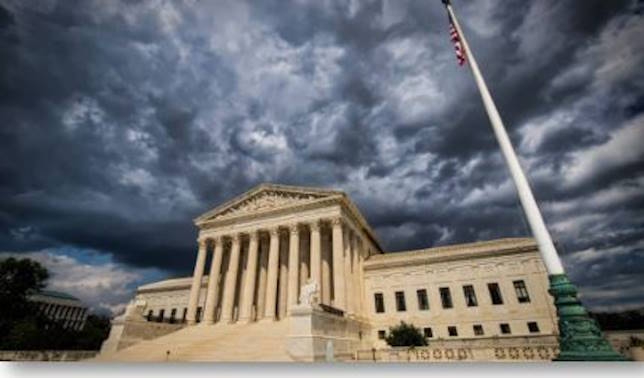
The Supreme Court Bump Stock Case: Defeat for the “Deep State”
By Rob Natelson
Justice Clarence Thomas’ opinion for the Supreme Court in Garland v. Cargill—the “bump stock firearms” case—may be more important for what it does not say than for what it does.
On its face, Cargill granted a statutory victory to gun owners. Below that, however, it granted a constitutional victory to all grassroots Americans and inflicted a defeat on the powerful federal bureaucracy—the “deep state.”
The topic addressed overtly was the ban on machine guns in the National Firearms Act of 1934. That law defines a “machine gun” as a firearm that can “shoot, automatically more than one shot . . . by a single function of the trigger.”
A “bump stock” uses a rifle’s recoil to enable a shooter to greatly increase the rate of firing. So the court had to decide whether a bump stock converts a semi-automatic weapon into a machine gun.
The “deep state” agency in the case was the Bureau of Alcohol, Tobacco, Firearms and Explosives (ATF). For many years the ATF took the position that a semiautomatic rifle with a bump stock was not a machine gun. But after a 2017 mass shooting in Las Vegas, Nevada, the ATF re-interpreted the Federal Firearms Act by categorizing bump stock firearms as machine guns. It then demanded that all citizens who, like Michael Cargill, owned such weapons surrender them to the ATF.
Around the same time, Congress refused to pass legislation reclassifying bump stock firearms as illegal machine guns.
Justice Thomas wrote for a six-person majority. He concluded that a bump stock rifle is not a machine gun. He held that the repeated fire allowed by a bump stock does not constitute “a single function of the trigger.” Rather, it merely accelerates separate functions. He also held that a bump stock’s repeated firing is not “automatic,” because the user must do more than merely hold back the trigger. The user also must maintain forward pressure on the rifle with his non-trigger hand.
Thus, in Cargill, the justices overruled an agency’s interpretation of a congressional law administered by the agency itself. That fact brings us to the underlying constitutional significance of the case.
Legal Props for the Deep State
In a previous column, I explained how, during the 20th century, liberal activist Supreme Court justices created four faux-constitutional legal props for the modern federal administrative state.
They created the first prop in the years around 1940: a series of decisions that swept away some of the former restraints on Congress’s powers. Under the manipulations of the liberal activists, the power to “regulate Commerce” became a blanket commission to command the entire economy. The power to “lay and collect Taxes” became authority to spend money for any purpose. Limited federal power to own land was rendered unlimited. And so forth.
Next, the 20th-century liberal activist justices put their collective thumbs on the scales against anyone challenging the constitutionality of a federal law. They ruled that one claiming a federal law was unconstitutional usually must prove his case beyond a reasonable doubt—generally an impossible standard to meet.
The liberal justices’ third step was to permit Congress to delegate massive swathes of its new-found authority to administrative agencies. Those agencies received not only the ability to make rules, but also to enforce the rules and adjudicate under them. To a great extent, this turned federal agencies into mixed legislative, executive, and judicial entities—thereby reversing the constitutional idea of “separation of powers.
The Chevron Case
In 1984 the court capped off this revolutionary process with its ruling in Chevron v. Natural Resources Defense Council. In Chevron, the court held that in most cases a federal agency could define the scope of its own power. If an agency’s interpretation of the statute under which it operated had a reasonable basis, a court would defer to the agency—even if the agency’s interpretation was not the best one. Chevron thus extended the same “deference” granted to laws enacted by a democratically-elected Congress to decrees issued by unelected bureaucrats.
When combined with the Supreme Court’s difficult “standing to sue” requirements, these changes assured that Congress and the deep state ruled America with few effective checks.
In my view, these four changes amounted to an illegitimate—if partial—coup d’etat, and the Supreme Court should revisit all of them. Unfortunately, none of the current members of the bench, except possibly Justice Thomas, has shown any stomach for re-examining the first three. But several have expressed interest in re-considering Chevron.
Moreover, in recent cases, the court has acted as if Chevron never existed. Cargill is one more example.
In Cargill, the court freely and fully examined the Federal Firearms Act. It used its own judgment to decide whether the agency’s interpretation of the law was correct. There is no sign in the court’s opinion of Chevron-style “deference,” and not even the three dissenters broached that subject.
Cargill is, therefore, another sign that Chevron is on its way out. Perhaps the court will complete the process of formally overruling that case during this term.
A version of this essay was first published in the June 19, 2024 Epoch Times.